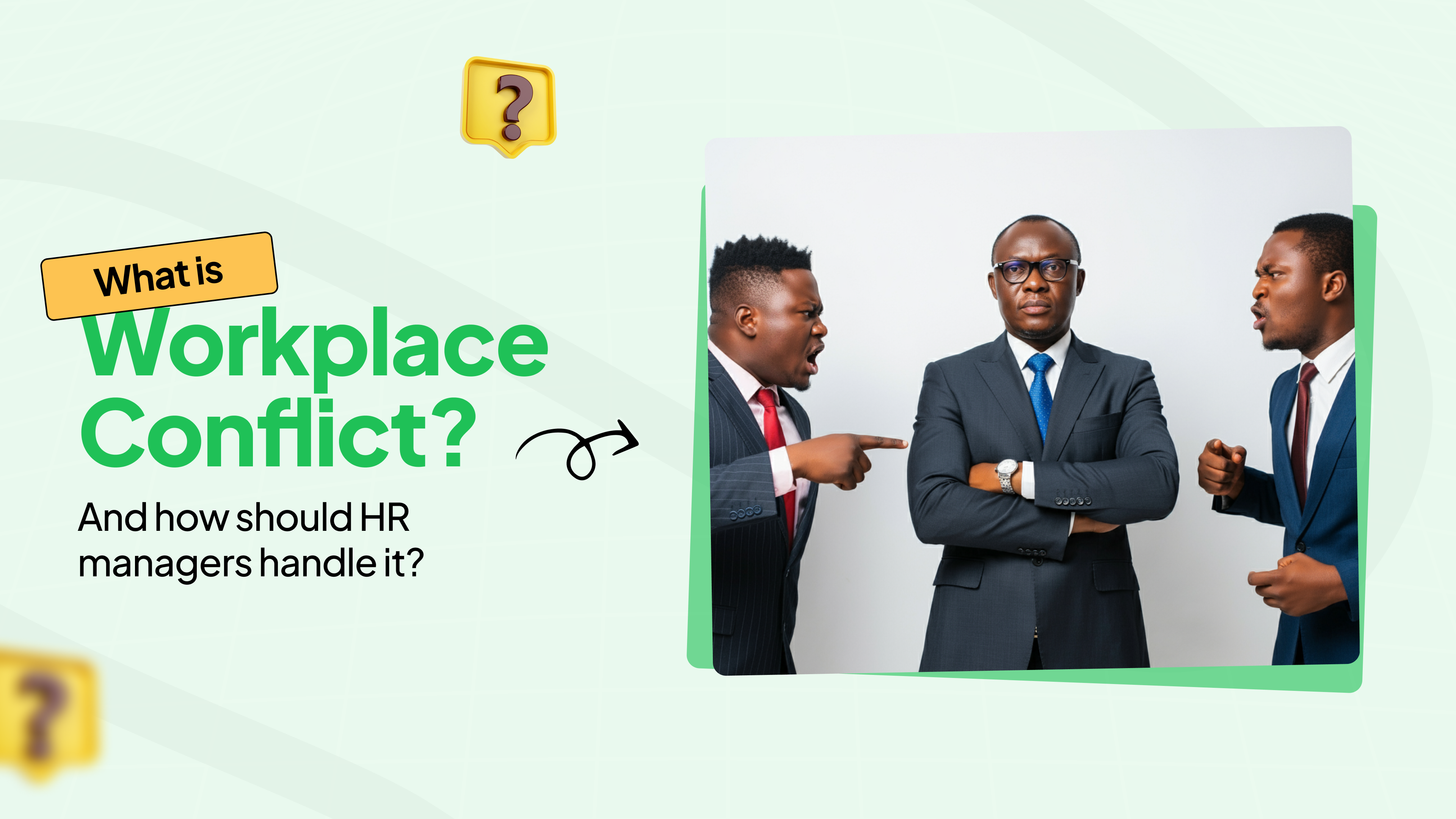
Tomilayo has finally had enough of Dumebi’s jeering and jesting. When she initially joined ZTA, she made a silly error that nearly cost her supervisor his job. Although the problem was resolved, and no one lost their heads, Dumebi from the web dev did not let her get past that error. Initially, Tomilayo took it as an initiation rite, “make a mistake as a newbie and let in some jokes at your expense”, but while everyone had moved past her mistake and begun to recognize her effort and the progress she added to the team as a brand designer, Dumebi hung to the joke. Eventually she boiled over and confronted Dumebi at the office lounge. A shouting contest ensued, and both employees found themselves before human resources.
Workplace conflicts are bound to occur, maybe not exactly like the scenario above. At the moment, every workplace involves humans from different backgrounds and with different personalities, and our AI overlords are yet to overrun our offices with unfeeling robots. There will definitely be clashes. It is important for a company’s human resource manager and the team to have measures in place to avoid conflicts and respond swiftly and efficiently when they break out.
Today we will be taking a deep dive into workplace conflict, its types and how HRs can anticipate and properly manage workplace conflicts.
What is Workplace Conflict?
The question on the tip of your tongue at the moment is, what exactly is workplace conflict? In simple terms, workplace conflicts refer to sharp disagreements between employees in a company. These conflicts can cut across positions, teams, and genders. The degree of seriousness of a workplace conflict can vary from simple misunderstandings to full-blown malice keeping in the office. You do not want that as an HR.

Workplace conflicts are caused by various factors, including differing ideologies, personalities, and poor communication. Subsequently, we will examine some of these causes better, but before then, what types of conflicts occur in workplaces?
What Types of Workplace Conflict Do We Have?
Workplace conflicts come in various shapes and colors, and categorizing them is quite a tricky task. In this section, we will look at two main classifications of workplace conflicts and the types we can find under both classes. This should help give context to workplace conflicts in your company and how to approach them.
Conflicts based on People.
This set of conflicts shows how conflicts can be classified based on the parties involved. Clarity here can help you identify the main parties and the scope of the conflict.
Interpersonal Conflict
The scenario introducing this piece falls under this category, and it is usually the more common type of conflict. Here, two people disagree over something that devolves to a workplace conflict. The causes of this conflict could be personal, ethical, task-related, and more. This sort of conflict can affect team morale and cause work delays especially if the parties involved work together on a project. If the parties are in the same team, it could evolve into an intragroup conflict, and if they are different teams it could turn into an intergroup conflict.
Individual vs Group Conflict
In this case, the conflict is between a person and a team or a group of individuals. Let’s paint a quick scenario. Josephine just joined the design team at Jarvis. Her portfolio was excellent, and the team lead who recommended her was quite aware that she used CorelDraw for most of her designs. While she understood and used the Adobe Suite, she felt it was less effective for her designs.

On the other hand, the rest of the design team are Adobe freaks, and while she has the rep to be accepted as a top designer, she is new to the team and vocal about her preference. She comes into conflict with the rest of the team. In this scenario, the workflow and the fact that Josephine is new to the team contribute to the individual vs. group conflict.
It is not uncommon for new employees to be the object of this type of conflict, especially if they are opinionated and share different philosophies from the existing team. This kind of conflict is not always a bad development, and how it is handled can help the whole team better bond and expand their ideologies.
Intragroup Conflict
Intragroup conflicts refer to conflicts within a group, team, or department. They often involve multiple people within that team on different sides of an issue. The issue could be an approach to a task or differing ideologies. It could be the graduation of an interpersonal or individual vs. group conflict.
Intergroup Conflict
Competition in a company is good, but when it takes a wrong turn, you could have intergroup conflicts. Intergroup conflicts can stem from a variety of sources, including miscommunication between teams, interpersonal conflicts, toxic work conditions, and more. In these situations, two departments are at loggerheads, and this could slow productivity for the entire company.
Conflicts based on situations/issues
This approach to examining conflicts involves looking at conflict from the perspective of the cause or source of these conflicts. This can help you, as an HRM, stay focused on the issues at hand while you identify underlying issues, too.
Task-Based conflict
Have you ever worked in a team and you disagreed on what task you are supposed to place priority on, or what the end goal of that task should be? Then, you have been in a task-based conflict. Task-based conflicts can occur because members of different teams are supposed to work together on a project. Someone from finance might be much more interested in cutting costs and maximizing profit; meanwhile, someone from marketing could be more interested in spending more on ads to increase reach and maximize profit. Even though both parties aim to maximize profit, their approaches and team responsibilities are different, and conflicts could arise.

Proper communication and allowing compromise will help ease employees and teams through this type of conflict.
Personality Based Conflict
Personality-based conflict is used as an umbrella term to cover conflicts that arise from the different personalities, ideologies, and philosophies of various employees in a company. It could also cover issues such as personal problems like depression or family issues that seep into workplaces and result in conflicts. These sorts of conflicts can be harmful depending on the gravity of the offense on either side.
A way to prevent and also resolve conflicts of this nature is to include empathy as a core pillar of your work culture.
Status Based Conflict
Status-based conflict is also considered as leadership-based conflict, and it revolves around conflicts caused by unclear hierarchies or resentments over established hierarchies. Mr Joseph has been a frontend developer at Keeys Technology for about 8 years now, but quite recently, the company hired Miss Aduago who studied Web development in University and has 5 years of experience in the field. After a year of working with the company, Miss Aduago was made the head of the development team. There is no need to complete the scenario before you begin to see ways in which there will be conflict in such a team. Status-based conflict also occurs when a team is set up within a company, involving members from different departments without a clear team lead.
Giving clear instructions and helping team members see why someone is given a chance above others could help diffuse status-based conflicts.
Process Based Conflict
Process-based conflicts analyze conflicts that stem from employees’ workstyle and work ethics. Some employees are like Batman; they like to work alone and sparingly do well in teams, others are like konoha ninjas who work best in 3 or 4 men teams. Some employees like to get to work on a project immediately, while others like to take their time to analyze every detail before taking action. Process-based conflicts often occur when employees with different or contrasting work styles have to work together.
A way to minimize this sort of conflict is to properly construct each team and clearly define each employee’s role in the team.
You should keep in mind that these classifications are not rigid. As an HR manager, you will see different elements of these types at play when conflicts arise, such as an intergroup conflict tied to a task or status conflict.
What are the main Causes of Workplace Conflict?
We have thoroughly looked at the different types of conflicts that can occur in any workplace, but what could cause these conflicts? If we are being honest anything can cause or devolve into a conflict but we will identify five popular causes of conflicts in most workplaces.

Communication Issues
There is no job or task that does not involve one form of communication or the other. Communication can be minimal for some roles or tasks, but there is always one form of communication or another in any workplace. Communication, or better put, miscommunication, is often one of the biggest causes of workplace conflict. There are a lot of nuances to communication, some of which depend on work culture, personalities, the message being communicated, and other factors. A small misinterpretation could lead to conflicts in the workplace.
Differing Values
In addressing communication above, we highlighted how nuances and social cues can affect communication and cause conflicts. This can be traced to the cultures, values, and perspectives of workers.
Having differing values can cause people to view things from conflicting perspectives. A manager who is constantly on a cost-cutting journey might not have a smooth working relationship with a sales representative who prioritizes spending any cost for the next sale. A worker who values details might have conflict with one who develops his process on the fly. Understanding and managing values can help mitigate conflicts arising from differing values.
Resource Scarcity
Talking about cutting costs and whatnot, finances in the workplace is another common cause of conflict. This ranges from payment of salaries to distribution of resources amongst teams. Unequal distribution or splitting of resources that do not reflect the value of particular departments could cause conflicts.
Resistance to change
No process or business style is immune to change. In fact, trying out new things is a way to improve workflow and learn better ways to carry out tasks, but as good as change is, it can also cause conflicts in the workplace.
As good as change is, it is difficult too. Imagine your boss comes to your office to inform you of a new tool, something you are unfamiliar with as the new standard, because it boosts productivity for your skill. Before you decide to climb the curve to learn the tool, there will be initial resistance, and in many cases, this can lead to minor or major conflicts in the workplace.
Poor Work Habits
Habits are learned behaviors that become fixed over time. There is no one, including you, without a quirk or habit. Some of these habits can be harmless in the workplace. If Esther always gets up to have a cup of water by noon, it is a habit that might keep her productive, but it is harmless. There are little habits that can cause conflicts such as constantly pacing to solve a problem. Pacing by itself might not be a problem, but when you are paired with a teammate who is sensitive to movement primarily when they work, this habit could be disruptive. But this is a relatively minor issue. Habits like consistently coming late, disorganization, or unrestrained outbursts when angry can easily trigger conflict in a workplace.
How to Resolve Workplace Conflicts
Now that you have identified some causes of workplace conflict, how can you handle Conflict when it occurs?

Improve communication.
Improving communication and encouraging more openness in your workplace is the first step to identifying and resolving conflict. The more employees communicate the easier it is for them to understand each other.
Improving communication can be as straightforward as calling occasional meetings in a free atmosphere and allowing employees to speak up without fear of punishment.
Mediation and Facilitation
Some conflicts cannot be resolved by the parties involved, and having a mediator step in is a great way to make headway in resolving such conflicts. Many times, human resource managers are trained in conflict resolution. This allows them to act as unbiased umpires striving to resolve conflicts between parties.
Observe body language.
This is more of a best practice for resolving conflicts and is more actionable for on-site teams. Observing the body language of the people in conflict can help indicate how open parties are to resolution. It can also serve as cue to help parties drive discussions forward properly.
Focus on the root cause.
Many conflicts linger because people only focus on the fruits of the conflict and not the roots. We have identified a couple of causes of conflict, and sometimes, each cause might require a different approach. Rather than just seeking to appease the conflicting parties, reaching out to find out what caused the conflict will produce long-term results.
Follow up.
Finding a solution or reaching a resolution when resolving a conflict is great, but what next? How do you know your solution is permanent? That’s where the act of following up becomes vital. Monitor the parties involved, track long-term progress, and other factors that might contribute to resolving future conflicts. The follow-up step can help formulate conflict resolution plans for further cases.
Preventing Workplace Conflict
The art of preventing workplace conflicts involves setting up safeguards to minimize the possibility of conflicts, and here are some ways you can do that for your employees.
- Foster clear communication channels.
- Define roles and expectations.
- Encourage team-building activities.
- Cultivate a positive workplace culture.
- Create regular feedback and performance review systems.
- Encourage work-life balance.
Conclusion
Managing workplace conflict can be quite challenging, especially when you do not understand its full scope. If you made it to this point, you are definitely more equipped to handle workplace conflicts than you could before. At the very least, you should be able to identify the different types of conflicts when you see them occur and proffer simple solutions to basic work conflicts.
Remember that your team thrives best when everyone is on the same page. Conflict resolution is not a simple task. It takes effort and can be time-consuming, but the results are well worth the effort.
